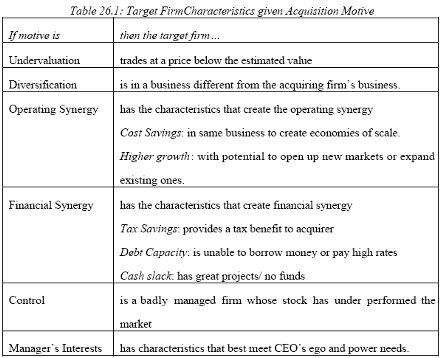Once a firm has an acquisition motive, there are two key questions that need to be answered. The first relates to how to best identify a potential target firm for an acquisition, given the motives described in the last section. The second is the more concrete question how to value a target firm, again given the different motives that we have outlined in the last section.
Choosing a target firm
Once a firm has identified the reason for its acquisition program, it has to find the appropriate target firm.
· If the motive for acquisitions is under valuation, the target firm must be under valued. How such a firm will be identified depends upon the valuation approach and model used. With relative valuation, an under valued stock is one that trades at a multiple (of earnings, book value or sales) well below that of the rest of the industry, after controlling for significant differences on fundamentals. Thus, a bank with a price to book value ratio of 1.2 would be an undervalued bank, if other banks have similar fundamentals (return on equity, growth, and risk) but trade at much higher price to book value ratios. In discounted cash flow valuation approaches, an under valued stock is one that trades at a price well below the estimated discounted cash flow value.
· If the motive for acquisitions is diversification, the most likely target firms will be in businesses that are unrelated to and uncorrelated with the business of the acquiring firm. Thus, a cyclical firm should try to acquire counter-cyclical or, at least, noncyclical firms to get the fullest benefit from diversification.
· If the motive for acquisitions is operating synergy, the typical target firm will vary depending upon the source of the synergy. For economies of scale, the target firm should be in the same business as the acquiring firm. Thus, the acquisition of Security Pacific by Bank of America was motivated by potential cost savings from economies of scale. For functional synergy, the target firm should be strongest in those functional areas where the acquiring firm is weak. For financial synergy, the target firm will be chosen to reflect the likely source of the synergy – a risky firm with limited or no stand-alone capacity for borrowing, if the motive is increased debt capacity, or a firm with significant net operating losses carried forward, if the motive is tax benefits.
· If the motive for the merger is control, the target firm will be a poorly managed firm in an industry where there is potential for excess returns. In addition, its stock holdings will be widely dispersed (making it easier to carry out the hostile acquisition) and the current market price will be based on the presumption that incumbent management will continue to run the firm.
· If the motive is managerial self-interest, the choice of a target firm will reflect managerial interests rather than economic reasons.
In Table 26.1, we summarize the typical target firm, given the motive for the take over.

There are two final points worth making here, before we move on to valuation. The first is that firms often choose a target firm and a motive for the acquisition simultaneously, rather than sequentially. That does not change any of the analysis in these sections. The other point is that firms often have more than one motive in an acquisitions, say, control and synergy. If this is the case, the search for a target firm should be guided by the dominant motive.
Valuing the Target Firm
The valuation of an acquisition is not fundamentally different from the valuation of any firm, although the existence of control and synergy premiums introduces some complexity into the valuation process. Given the inter-relationship between synergy and control, the safest way to value a target firm is in steps, starting with a status quo valuation of the firm, and following up with a value for control and a value for synergy.
a. Status Quo Valuation
We start our valuation of the target firm by estimating the firm value with existing investing, financing and dividend policies. This valuation, which we term the status quo valuation, provides a base from which we can estimate control and synergy premiums. All of the basic principles presented in chapter 24 on valuation continue to apply here. In particular, the value of the firm is a function of its cash flows from existing assets, the expected growth in these cash flows during a high growth period, the length of the high growth period, and the firm’s cost of capital.
Prof. Aswath Damodaran
Next: In Practice 26.1: A Status Quo Valuation of Digital
Summary: Index